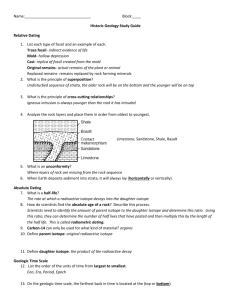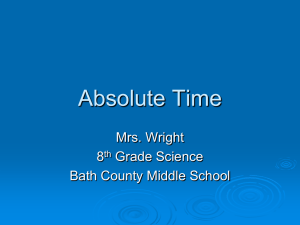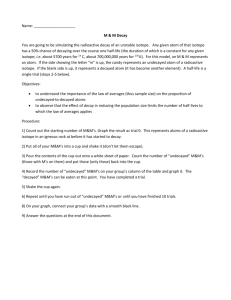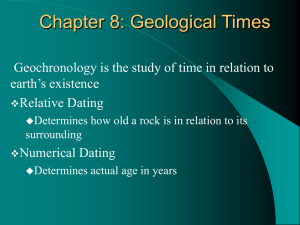- jwhitti8
advertisement
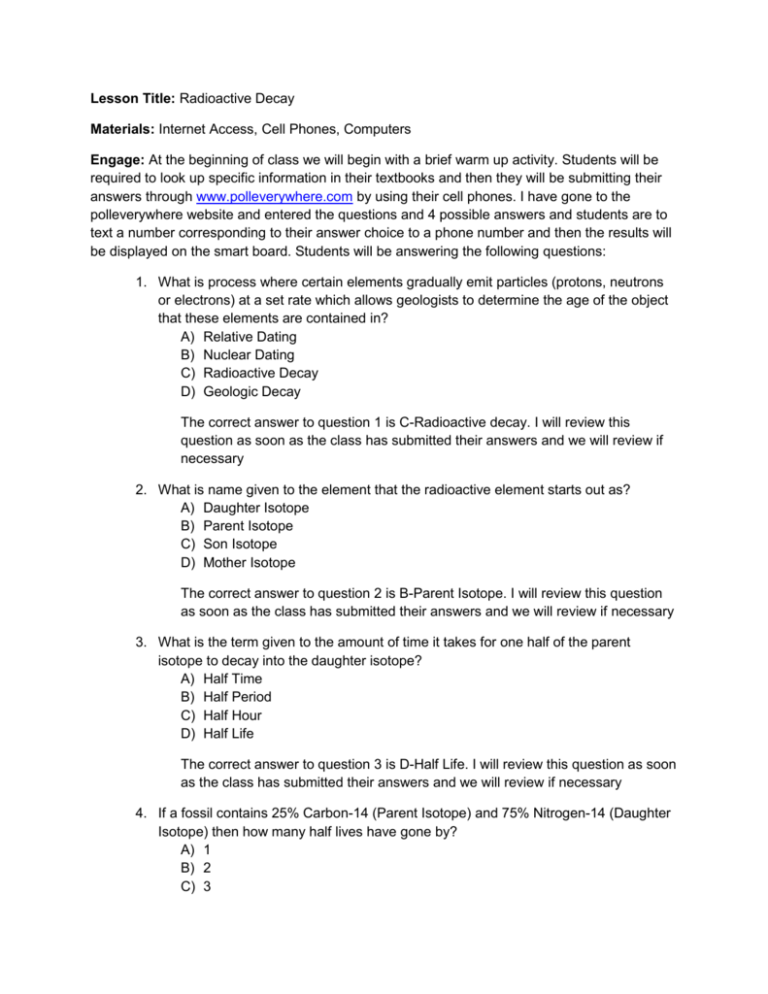
Lesson Title: Radioactive Decay Materials: Internet Access, Cell Phones, Computers Engage: At the beginning of class we will begin with a brief warm up activity. Students will be required to look up specific information in their textbooks and then they will be submitting their answers through www.polleverywhere.com by using their cell phones. I have gone to the polleverywhere website and entered the questions and 4 possible answers and students are to text a number corresponding to their answer choice to a phone number and then the results will be displayed on the smart board. Students will be answering the following questions: 1. What is process where certain elements gradually emit particles (protons, neutrons or electrons) at a set rate which allows geologists to determine the age of the object that these elements are contained in? A) Relative Dating B) Nuclear Dating C) Radioactive Decay D) Geologic Decay The correct answer to question 1 is C-Radioactive decay. I will review this question as soon as the class has submitted their answers and we will review if necessary 2. What is name given to the element that the radioactive element starts out as? A) Daughter Isotope B) Parent Isotope C) Son Isotope D) Mother Isotope The correct answer to question 2 is B-Parent Isotope. I will review this question as soon as the class has submitted their answers and we will review if necessary 3. What is the term given to the amount of time it takes for one half of the parent isotope to decay into the daughter isotope? A) Half Time B) Half Period C) Half Hour D) Half Life The correct answer to question 3 is D-Half Life. I will review this question as soon as the class has submitted their answers and we will review if necessary 4. If a fossil contains 25% Carbon-14 (Parent Isotope) and 75% Nitrogen-14 (Daughter Isotope) then how many half lives have gone by? A) 1 B) 2 C) 3 D) 4 The correct answer to question 4 is B-2. (0 Half lives: 100% Parent, 0% Daughter, 1 Half life: 50% Parent, 50% Daughter, 2 Half lives: 25% Parent, 75% Daughter, etc.) I will review this question as soon as the class has submitted their answers and we will review if necessary. Explore: After the class has finished the warm up activity we will go over the notes on radioactive decay and absolute dating. Students have been handed guided notes where they have a print out of the notes and they are to fill in the blanks as I present the material. All of the notes are on a power point presentation which has several pictures and visual aids. The purpose of today’s lesson is to introduce a method in which geologists determine the ages of rocks and fossils. In the previous lesson we determined that older objects are generally buried further underground however we were not able to determine the exact age of the rock. Today we will be learning a method in which we will determine the exact age. In many rocks and fossils there are certain elements that are radioactive. These radioactive elements are constantly losing protons, neutrons or electrons which are the components of elements. As this occurs the radioactive element is slowly turning into a different element. The name given to the original element is called the “parent isotope” and the name given to the new element, what the parent isotope is turning into is called the “daughter isotope”. Different elements decay at different rates. For example Carbon-14 (parent isotope) decays into Nitrogen-14 (daughter isotope) over a couple thousand years. However Uranium 238 (parent isotope) decays into Lead-206 (daughter isotope) very slowly over billions of years. Every parent:daughter isotope pair has a half life. A half life is the amount of time it takes for one half of the parent isotope to decay into the daughter isotope Example Carbon-14 (parent isotope) and Nitrogen-14 (daughter isotope) have a half life of 5730 years. So when the fossil first forms it contains 100% Carbon-14 and 0% Nitrogen-14. Then after 5730 years half of the carbon turns into nitrogen so at this point in time it contains 50% Carbon-14 and 50% Nitrogen-14. Then another 5730 years goes by (11460 years total) and the remaining 50% of Carbon 14 gets cut in half so now the fossil contains 25% Carbon-14 and 75% Nitrogen 14 (2nd half life). Then another 5730 years goes by and the remaining 25% of Carbon-14 gets cut in half a third time and now there is 12.5% Carbon-14 and 87.5% Nitrogen14 (3rd Half Life). This concept is illustrated on the chart below: Number Of Half Lives 0 1 2 3 4 5 % Parent Isotope 100 50 (1/2) 25 (1/4) 12.5 (1/8) 6.25 (1/16) 3.175 (1/32) % Daughter Isotope 0 50 (1/2) 75 (3/4) 87.5 (7/8) 93.75 (15/16) 96.875 (31/32) The way that geologists use this information is when they uncover a rock or fossil they use a geiger counter to determine the percentages of the parent isotopes and daughter isotopes. From that information they determine how many half lives have gone by. After they have the number of half lives they multiply the number of half lives that have gone by, by how long each half life is. Example: A rock contains 25% Uranium 235 (parent isotope) and 75% Lead 207 (daughter isotope). How old is the rock (The Half Life of Uranium 235 is 700 million years.) From the chart we can see that if there is 25% parent isotope left then 2 half lives have gone by. If each half life is 700 million years then 2 X 700 million = 1.4 Billion Years After we have gone over this information we will watch a brainpop video on this content. Brainpops are short 3-4 minute cartoons on various scientific concepts and can be beneficial for very visual learners. After we have watched that we will do a couple of sample problems on polleverywhere.com. They are as follows: 1. If a rock contains 50% Potassium-14 and 50% Argon-40 then how old is the rock (Half life of K-40 is 1.3 Billion Years) A. 65 Million Years B. 1.3 Billion Years C. 2.6 Billion Years D. 3.9 Billion Years The answer is B-1.3 Billion Years 2. If a fossil has a Carbon-14:Nitrogen-14 ratio of 1:15 then how old is the fossil? (Carbon 14 Half life is 5730 years) A. 5730 Years B. 11450 Years C. 17190 Years D. 22920 Years The answer is D-22920 3. A rock contains 12.5% Uranium 235 and 87.5% Lead 207. How old is the rock (Half life of U-235 = 700 million years) A. 700 Million Years B. 1.4 Billion Years C. 2.1 Billion Years D. 2.8 Billion Years The answer is C-2.1 Billion Years Engage: When we have finished the practice questions we will be going to the computer lab/library to work on the virtual radioactivity lab. This lab consists of 2 sections. The first section is an online tutorial where students will be going through a series of questions on radiometric dating and they will have to answer several multiple choice questions. They will not be allowed to procedure to the next section until they answer every question correctly. The activity is located at the following website: http://www.sciencecourseware.org/virtualdating/files/2.0_HalfLife.html When students have successfully completed this section they will be moving onto the virtual lab activity. The purpose of this activity is for students to confirm the relationship between how old a rock or fossil is and how far it is located beneath the surface. The previous lesson involved relative dating and one critical aspect of relative dating was that generally the older rocks or fossils are located further beneath the surface. Students will being by going to the following website: http://phet.colorado.edu/en/simulation/radioactive-dating-game. This website is a virtual lab where students are carrying out a lab investigation but instead of it being done in a classroom it is instead done on a computer. In this virtual lab students are analyzing a hypothetical rock outcrop as seen below: You? Download Run Now! 5,039 kB Version: 3.26 (change log) Embed On this diagram there are several objects such as skeletons, fossils, rocks, etc. and they are all incased inside of a rock layer. As well there is a gieger counter and a chart that shows the relationship between how many parent isotope atoms there are and how many half lives have gone by. What the students objective is is to point the Geiger counter at each object. The Geiger counter then tells them either how much Carbon is in the object or how much Uranium is in the object. Students then use the chart above to determine how many half lives have gone by. Then they multiply how many half lives have gone by, by how long each half life is to determine how old the object is just like they did in the practice problems. As students complete this work they are to fill out a lab sheet that I distributed back in the classroom. Evaluate: After students have completed the virtual lab they are then to write a lab report on their findings. The final product on this lab report should be a prezi presentation with the following information provided. There are six sections that students are to complete and they are to put each section on a separate slide with an appropriate heading: Introduction: Students are to write a 2-3 paragraph introduction explaining the following: o What is radiometric dating? o What is meant by a parent and daughter isotope? o What is a half life? o Name an example of a parent:daughter isotope pair o How do geologists use this information in dating rocks? o What is generally the relationship between how old an object is and how deep it is buried? o Explain the steps you took in the lab Hypothesis: Write a 1 sentence hypothesis that explains what you predicted would happen in the experiment as far as the relationship between how deep the object was buried and how old it was? Data Table: Recreate the data table from the lab sheet and put it in the prezi presentation. The table should look as follows: Object Carbon-14 Uranium-238 % of Original Guessed Age Measured Age Animal Skull Living Tree Distant Living Tree House Dead Tree Bone Wooden Cup 1st human skull 2nd human skull Fish Bones Fish Fossil 1 Rock 1 Dinosaur Skull Rock 2 Trilobite Rock 3 Rock 4 Rock 5 Graph: Construct a bar graph that shows the ages of each object. Plot the object on the X-axis in order of their depth from the surface and then plot the absolute age of the object on the Y-Axis. Use Microsoft Excel Conclusion: Write a 1-2 paragraph conclusion that covers the following: o Which object was the oldest? Which object was the youngest? o What was the general relationship in the lab between the absolute age of the object and the depth at which it is found? o Which isotope was better for dating really old objects? Which isotope was better for dating really young objects o Re-Evaluate your hypothesis. Does your data support it or refute it? o Explain what you learned in the lab Sources Of Error: Name three things that may have gone wrong in the experiment that could have impacted your results When students have finished their prezi presentations they are to give a presentation to the class and explain what their data was and what it told them about these objects.
